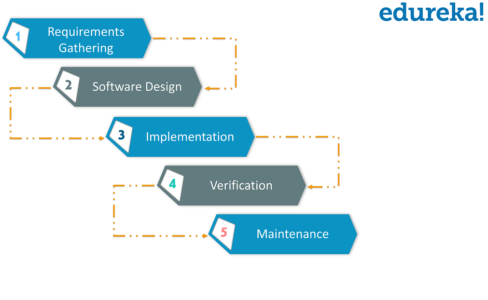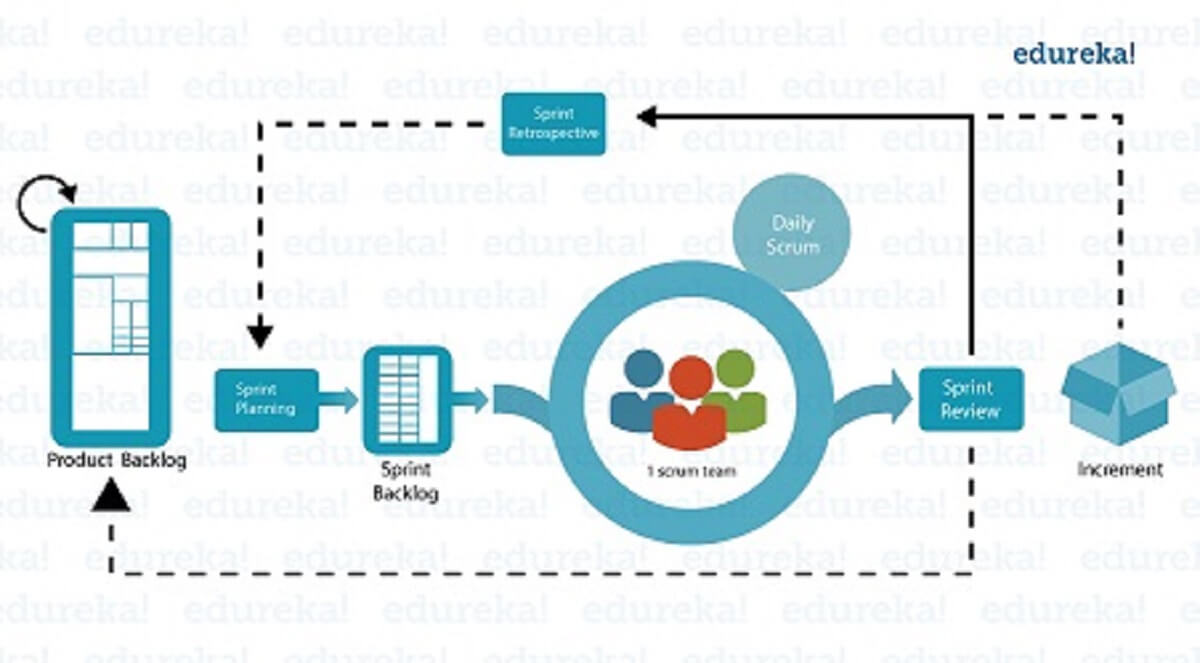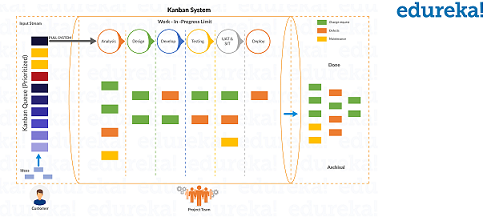DevOps Certification Training Course
- 174k Enrolled Learners
- Weekend/Weekday
- Live Class
Gone are the days of using traditional software development models such as the Waterfall model. In today’s fast-paced IT world Agile is a new way forward. So in this blog, I will discuss What is Agile methodology. After reading this blog, your understanding of Agile will be crystal clear. Post Agile, the next preferred step would be learning DevOps and its certification course.
In this blog, we will cover the following topics:
So without wasting any time, let us begin the discussion.
Before Agile came into the picture, we had the Waterfall model of software development. The waterfall model can be defined as a sequential process in the development of a system or software that follows a top-down approach. This model was a straight forward and linear model. The waterfall model had various phases such as Requirements Gathering, Software Design, Implementation, Testing, Deployment, and Maintenance.

This model however suffered a few drawbacks such as follows:
Due to the above-mentioned drawbacks of the Waterfall model, the leaders from the different development methodologies decided to meet to find a way forward through these problems. These leaders agreed upon a lightweight development method and they were also able to give wordings for the same in the form of a manifesto. It was called ” The Manifesto for Agile Software Development”. This manifesto contains 4 Values and 12
principles.
Now let us try to understand What exactly is Agile. Agile Software development is an approach under which requirements and solutions evolve through the collaborative effort of self-organizing and cross-functional teams and their customer(s)/end user(s). It advocates adaptive planning, evolutionary development, early delivery, and continual improvement, and it encourages rapid and flexible response to change.

Agile software development allows the team to work together more efficiently and effectively to develop complex projects. It consists of practices that exercise iterative and incremental techniques that are easily adopted and display great results.
The 4 values of the Agile Manifesto are as follows:
The 12 principles that are mentioned in the Agile Manifesto are as follows:
The various advantages offered by AGILE methodology are as follows:
The AGILE methodology can be implemented with the help of various frameworks such as Scrum, Kanban, eXtreme Programming(XP), Lean, Crystal, Adaptive Project Framework(APF), Feature Driven Development(FDD), Dynamic Systems Development Method(DSDM), Agile Unified Process(AUP) and so on.
In this topic, we will discuss the top 5 AGILE frameworks.
Scrum is a framework within which people can address complex adaptive problems, while productively and creatively delivering products of the highest possible value. It is a simple framework for effective team collaboration on complex products. It is the most popular and widely followed Agile methodology.
 The Scrum framework addresses two critical pain points of software development. First is the speed of software development and the second is client requirements which keep on changing. In this approach, the software development project is executed in phases and each phase known as a Sprint. Also, small teams of 5-6 members are created, who collectively work towards the desired results.
The Scrum framework addresses two critical pain points of software development. First is the speed of software development and the second is client requirements which keep on changing. In this approach, the software development project is executed in phases and each phase known as a Sprint. Also, small teams of 5-6 members are created, who collectively work towards the desired results.
The Scrum methodology allows active client participation at each stage so that any required changes are addressed immediately and acted on. This ensures that the project is delivered within time and meets the client demands effectively.

XP is the most successful method of developing agile software because of its focus on customer satisfaction. XP requires maximum customer interaction to develop the software. It divides the entire software development life cycle into several numbers of short development cycles. It welcomes and incorporates changes or requirements from the customers at any phase of the development life cycle.
Extreme programming starts with collecting user requirements. Depending upon these requirements the whole development process is divided into several small numbers of cycles. So the next phase is iteration planning i.e. deciding the no of cycles, prioritizing the requirements and estimating the amount of effort required to implement each cycle.
Now each iteration is developed using pair programming. During the development phase, new user requirements may come and the iteration plan should be adjusted according to that.
The next step is to test the latest developed version for bugs if detected; the bugs will be removed in the next iteration. After every acceptance testing project tracing should be done in which feedback is taken from the project that how many jobs have already been done. XP has introduced many new things for developers like pair programming, extensive code review, code refactoring, and open workspace.

An engineer from Toyota called Taiichi Ohno invented the Kanban framework. Somewhere around the late 1940s, the representatives of Toyota company observed how supermarkets restock their goods based on what has been picked off the shelves. So Toyota came up with a system where actual consumption drives the production plans.
One of the core ideas of Kanban is to refrain from producing a surplus. This is achieved by making use of Kanban cards and a Kanban board. They are also used to visualize the flow of resources throughout the production cycle. This gives everyone maximum insight into the process. This also helps managers address whatever the surplus or the shortage is in real time.
The Kanban system also introduces the notion of “pull” over “push,” meaning that workers pull in work according to their capacity, as opposed to work being fed to them on a conveyor belt or in the form of a to-do list.
This method of software development is based on the principle “Just in time production”. The aim of Lean is to increase the speed of software development and to reduce its cost. The seven steps to summarize Lean development are as follows:
Delete unnecessary things (everything that does not bring effective value to the customer’s project is deleted);
Quality development (creating quality in development requires discipline and control of the number of residuals created);
Create Knowledge (the team is motivated to document the whole infrastructure to later retain that value);
Differing commitments (this point encourages the team not to focus too much on planning and anticipating ideas without having a prior and complete understanding of the requirements of the business);
Fast delivery (deliver value to the customer as soon as possible);
Respecting the team(communicating and managing conflicts are two essential points);
Optimize the whole (the development sequence has to be perfected enough to be able to delete errors in the code, in order to create a flow of true value).

Crystal Methods are a family of software development methodologies. Alistair Cockburn developed these methods from his study and interviews with teams. The color-coded methods signify the risk to human life. For example, projects that may involve risk to human life will use Crystal Sapphire while projects that do not have such risks will use Crystal Clear.
Crystal focuses on six primary aspects: people, interaction, community, communication, skills, and talents. Consider the process as secondary. There are also seven common properties in Crystal that indicate a higher possibility of success and they include frequent delivery, reflective improvement, osmotic communication, and easy access to expert users.
The methods are very flexible and avoid rigid processes because of their human-powered or people-centric focus. Alistair Cockburn is also one of the original signatories of the Agile Manifesto.
Crystal Methods consider people as the most important, so processes should be modeled to meet the requirements of the team. It is adaptive, without a set of prescribed tools and techniques. It is also lightweight, without too much documentation, management or reporting.
The project environment and team size determine the weight of the methodology. For example, Crystal Clear is for short-term projects by a team of 6 developers working out of a single workspace
Now that you have understood what AGILE is, check out this DevOps training by Edureka, a trusted online learning company with a network of more than 250,000 satisfied learners spread across the globe. The Edureka DevOps Certification Training course helps learners to understand what is DevOps and gain expertise in various DevOps processes and tools such as Puppet, Jenkins, Nagios, Ansible, Chef, Saltstack and GIT for automating multiple steps in SDLC.
Got a question for us? Please mention it in the comments section and we will get back to you
| Course Name | Date | Details |
|---|---|---|
| DevOps Certification Training Course | Class Starts on 3rd August,2024 3rd August SAT&SUN (Weekend Batch) | View Details |
| DevOps Certification Training Course | Class Starts on 12th August,2024 12th August MON-FRI (Weekday Batch) | View Details |
| DevOps Certification Training Course | Class Starts on 7th September,2024 7th September SAT&SUN (Weekend Batch) | View Details |
 REGISTER FOR FREE WEBINAR
REGISTER FOR FREE WEBINAR  Thank you for registering Join Edureka Meetup community for 100+ Free Webinars each month JOIN MEETUP GROUP
Thank you for registering Join Edureka Meetup community for 100+ Free Webinars each month JOIN MEETUP GROUP
edureka.co
